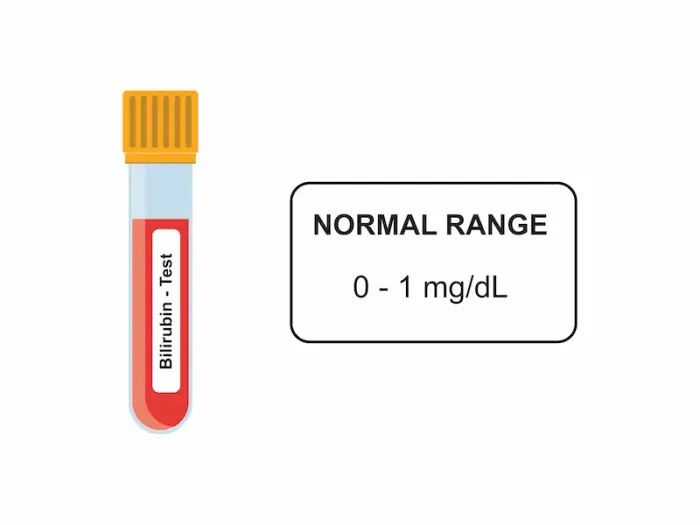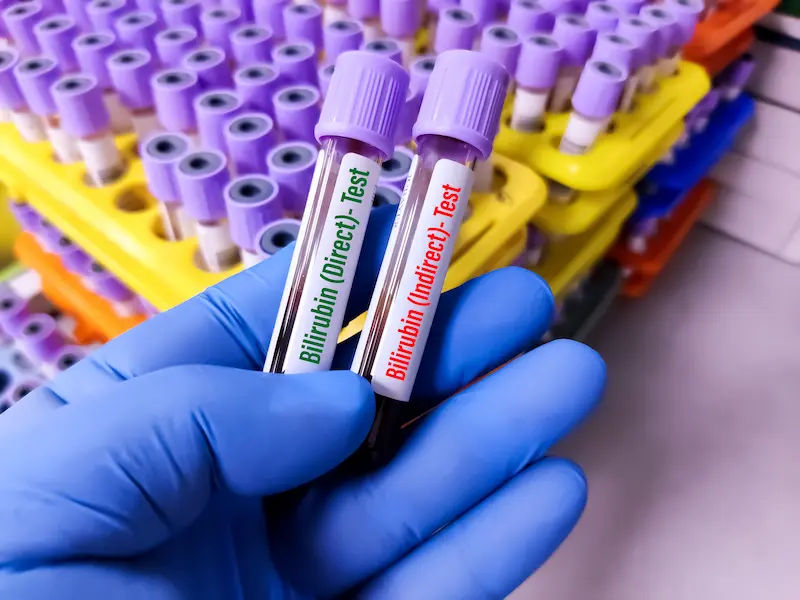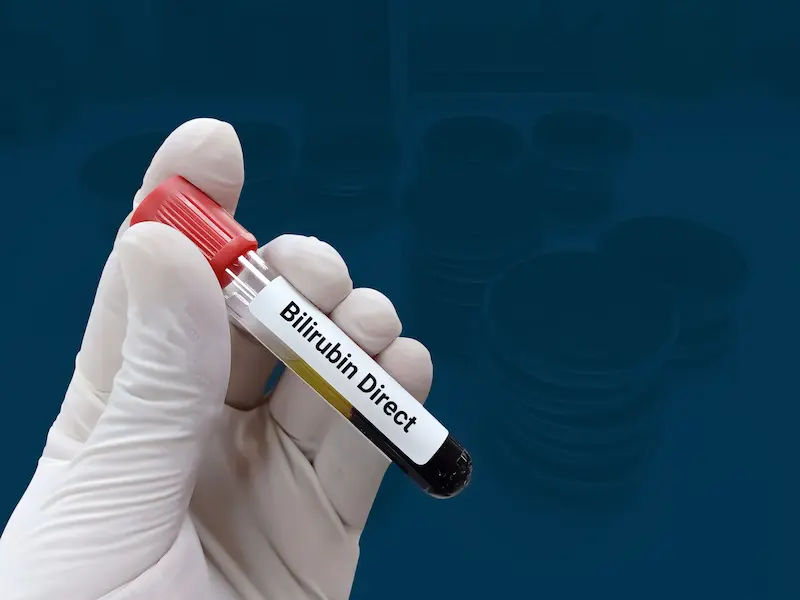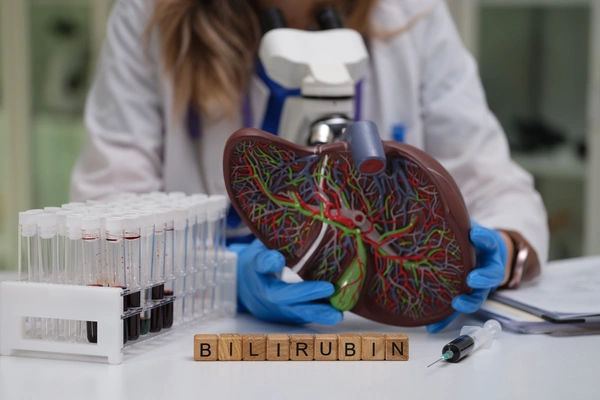Bilirubin Test Normal Range, What It Means, and Next Steps
A bilirubin test checks how well your body processes and removes bilirubin, a yellow pigment from red blood cells. Understand normal bilirubin ranges, causes of high levels, and when to seek medical advice. Includes guidance for adults, children, and newborns.

Written by Dr. Md Yusuf Shareef
Reviewed by Dr. Dhankecha Mayank Dineshbhai MBBS
Last updated on 29th Oct, 2025

Introduction
If your doctor ordered a bilirubin test or you noticed “bilirubin” highlighted on a recent lab report, you are not alone. This simple blood test helps evaluate how your body processes and clears a yellow pigment called bilirubin. Knowing the normal range for bilirubin—and what it means when your level falls outside that range—can reduce uncertainty and help you take the right next step.
In this guide, we explain what the test measures, how bilirubin forms in the body, typical normal ranges for adults and newborns, and how to interpret results alongside other liver tests. You will also learn the common causes of high bilirubin, the differences between direct and indirect bilirubin, and what to do if results are not in the expected range. Whether reviewing your own report or preparing for a test, this guide offers clear, clinically relevant information to help you make informed choices. Consult a Top Hepatologist for Personalised Advice
What Is Bilirubin and Why Does It Matter
This section explains where bilirubin comes from and why it is essential for assessing liver and bile duct health.
How Your Body Makes Bilirubin
Bilirubin is produced when your body breaks down old red blood cells. The pigment initially forms as indirect (unconjugated) bilirubin, which is not water-soluble and travels to the liver attached to albumin. Liver cells convert it into direct (conjugated) bilirubin so it can pass into bile and be excreted through the intestines. Any disruption in this pathway can lead to bilirubin buildup and visible jaundice.
Direct (Conjugated) vs Indirect (Unconjugated) Bilirubin
• Indirect bilirubin rises when red blood cells are broken down too quickly or when the liver struggles to convert bilirubin effectively.
• Direct bilirubin rises when the liver can process bilirubin but the bile ducts cannot properly drain it.
Understanding which portion is high provides strong clues to the underlying cause.
Where the Bilirubin Test Fits in a Liver Panel
Bilirubin is commonly measured alongside ALT, AST, ALP, GGT and albumin. The pattern of changes matters most:
• Higher ALP and GGT → bile duct problem
• Higher ALT and AST → liver cell injury
• High bilirubin alone → may reflect overproduction or minor processing issues
The Bilirubin Test: What It Measures and How It’s Done
This section describes how bilirubin is checked and what may influence results.
Total vs Direct (and Calculated Indirect) Bilirubin
A typical report includes:
• Total bilirubin — the overall amount in the blood
• Direct bilirubin — the water-soluble portion
Indirect bilirubin is usually calculated (Total − Direct), which is clinically reliable for most people.
Test Preparation, Timing, and Safety
The test involves a small blood sample from a vein. Some labs recommend a short fast (about 4 hours), while others do not. Morning tests may align well with fasting and other planned investigations. Side effects are minimal, such as slight bruising or brief discomfort.
Common Factors That Can Affect the Test Result
• Certain medicines (e.g., antiviral drugs, steroids, some antibiotics)
• Fasting or heavy exercise, especially in those with Gilbert syndrome
• Blood sample handling (avoid excessive pressure or prolonged tourniquet use)
Always inform your clinician about medicines, supplements, and recent illnesses.
Normal Range for Bilirubin: Adults, Children, and Newborns
This section shows what counts as normal in different age groups.
Adult Normal Range
Typical laboratory reference intervals:
• Total bilirubin: roughly 0.1–1.2 mg/dL (about 1.7–20.5 μmol/L)
Always compare with the lab’s range on your own test report.
Direct vs Indirect Bilirubin Normal Range
• Direct bilirubin: usually 0.0–0.3 mg/dL
• Indirect bilirubin: the difference between total and direct; normally a small share of total
A higher direct portion suggests bile flow issues, while a higher indirect portion points to increased breakdown or reduced liver processing.
Newborns and Children: Why the Range Is Different
Babies naturally have higher bilirubin in the first week due to rapid red blood cell turnover and an immature liver. Levels peak around day 3–5 and then fall. Paediatric teams use age-in-hours charts to decide on testing and treatment. If you are concerned about a baby’s jaundice, seek prompt review.
H4: Quick mg/dL to μmol/L Conversion Guide
mg/dL × 17.1 ≈ μmol/L. Example: 1.0 mg/dL ≈ 17.1 μmol/L
Understanding Your Results in Context
This section explains how bilirubin fits into the wider clinical picture.
Patterns with ALT, AST, ALP, and GGT
• Hepatocellular pattern: Liver inflammation raises ALT/AST most
• Cholestatic pattern: Blocked bile flow raises ALP and GGT most
• Isolated indirect bilirubin: Consider haemolysis or Gilbert syndrome
Clues from symptoms and history improve accuracy.
Example Scenarios
• Gilbert syndrome: Mild, intermittent indirect bilirubin; harmless; triggered by fasting or stress
• Hepatitis: High ALT/AST, dark urine, fatigue; further viral tests needed
• Gallstones: Pain, fever, jaundice with high direct bilirubin; ultrasound required urgently
When a “Borderline High” Level Is or Isn’t Concerning
Mild elevations (e.g., 1.3–2.0 mg/dL) without other abnormalities often reflect harmless causes. Persistent or rising levels, or jaundice with dark urine and pale stools, should be investigated promptly.
Causes of High Bilirubin: From Blood to Bile Duct
This section groups the most common reasons bilirubin rises.
Prehepatic Causes (Before the Liver)
Overactive red blood cell breakdown:
• Autoimmune haemolytic anaemia
• G6PD deficiency
• Sickle cell disease and other haemoglobin disorders
Tests may include reticulocyte count, LDH, haptoglobin, and blood smear.
Hepatic Causes (Liver Cell Problems)
Impaired bilirubin processing due to:
• Viral hepatitis (A, B, C)
• Fatty liver disease (NAFLD/NASH)
• Alcohol-related liver disease
• Medication-related injury
• Cirrhosis
Cholestatic/Obstructive Causes (Bile Flow Problems)
Examples:
• Gallstones blocking ducts
• Tumours near the bile ducts or pancreas
• Bile duct scarring or inflammation
Imaging such as ultrasound or MRCP may be recommended.
Hereditary Conditions
• Gilbert syndrome: Common, mild, indirect bilirubin rise
• Dubin–Johnson/Rotor syndromes: Mild, direct bilirubin rise
• Crigler–Najjar syndrome: Rare, severe, requires specialist care
Special Case: Bilirubin in Newborns
This section highlights why newborn jaundice needs careful monitoring.
Physiologic Jaundice and Normal Trajectory
Most term babies show some jaundice in the first week. Feeding support and observation are usually all that is needed. Values are judged using recognised charts, not adult ranges.
Warning Signs and When to Seek Care
Seek urgent assessment if:
• Jaundice appears within the first 24 hours
• Baby is very sleepy, feeding poorly, or very irritable
• Jaundice worsens rapidly or persists beyond two weeks
If you are unsure, consult a paediatrician promptly; online consultation with Apollo 24|7 is also available.
Treatment Overview
Phototherapy is commonly used to lower bilirubin by converting it to a form the body can remove. In rare, severe cases, exchange transfusion may be required. Any underlying cause, such as blood group incompatibility or infection, must be treated.
What To Do Next: Preparation, Follow-Up, and When to Seek Care
This section helps you plan your next medical steps confidently.
Preparing for the Next Test and Improving Accuracy
• Confirm fasting requirements
• Avoid heavy exercise beforehand
• Provide a full medication history
• Prefer morning appointments for convenience
Apollo 24|7 offers home sample collection to help ensure consistent test conditions.
Follow-Up Tests
Depending on your pattern:
• Isolated indirect rise → haemolysis studies; consider Gilbert syndrome
• Hepatocellular pattern → hepatitis testing, imaging, lifestyle review
• Cholestasis pattern → ultrasound, possibly MRCP or specialist referral
When to Call a Doctor
Urgent care is needed if you have:
• Jaundice with fever or severe abdominal pain
• Confusion or extreme tiredness
• Dark urine and pale stools
If symptoms persist or worsen despite the above measures, arrange a physical visit or book an online consult with Apollo 24|7 to clarify results and plan treatment.
Conclusion
A bilirubin test provides key insights into liver function, bile duct health, and red blood cell turnover. Understanding the normal range—about 0.1–1.2 mg/dL for adults—and the difference between direct and indirect bilirubin helps you interpret your results clearly. Context is essential: other liver tests, symptoms, and medical history indicate the most likely cause. In newborns, bilirubin is assessed using age-specific guidelines to ensure timely treatment when needed.
If your level is slightly raised but you feel well, there may be a harmless explanation. However, persistent abnormalities or concerning symptoms should prompt medical evaluation. With convenient testing and expert guidance available through Apollo24|7, the right next step is always within reach. Consult a Top Hepatologist for Personalised Advice
Consult a Top Hepatologist for Personalised Advice

Dr. Srinivasa Reddy
Hepatologist
12 Years • MBBS, MD (General Medicine), DM (Hepatology),ASGE
Hyderabad
Myra Liver & Gastro Care, Hyderabad

Dr. E Prabhakar Sastry
General Physician/ Internal Medicine Specialist
40 Years • MD(Internal Medicine)
Manikonda Jagir
Apollo Clinic, Manikonda, Manikonda Jagir
(150+ Patients)

Dr. Sushith C
General Physician
2 Years • MBBS
Bengaluru
PRESTIGE SHANTHINIKETAN - SOCIETY CLINIC, Bengaluru

Dr. Pukhraj Singh Jeji
Gastroenterology/gi Medicine Specialist
13 Years • MBBS, MD ( Internal Medicine ), DM ( Gastroenterology ), Consultant - Gastroenterology
Bhubaneswar
Apollo Hospitals Old Sainik School Road, Bhubaneswar

Dr. Kumaragurubaran. S
Hepatologist
0 Years • MBBS.,MD.,FPIC.,DM.,
Tiruchirappalli
Apollo Speciality Hospitals Old Palpannai, Tiruchirappalli
(25+ Patients)
Consult a Top Hepatologist for Personalised Advice

Dr. Srinivasa Reddy
Hepatologist
12 Years • MBBS, MD (General Medicine), DM (Hepatology),ASGE
Hyderabad
Myra Liver & Gastro Care, Hyderabad

Dr. E Prabhakar Sastry
General Physician/ Internal Medicine Specialist
40 Years • MD(Internal Medicine)
Manikonda Jagir
Apollo Clinic, Manikonda, Manikonda Jagir
(150+ Patients)

Dr. Sushith C
General Physician
2 Years • MBBS
Bengaluru
PRESTIGE SHANTHINIKETAN - SOCIETY CLINIC, Bengaluru

Dr. Pukhraj Singh Jeji
Gastroenterology/gi Medicine Specialist
13 Years • MBBS, MD ( Internal Medicine ), DM ( Gastroenterology ), Consultant - Gastroenterology
Bhubaneswar
Apollo Hospitals Old Sainik School Road, Bhubaneswar

Dr. Kumaragurubaran. S
Hepatologist
0 Years • MBBS.,MD.,FPIC.,DM.,
Tiruchirappalli
Apollo Speciality Hospitals Old Palpannai, Tiruchirappalli
(25+ Patients)
Frequently Asked Questions
1️. What is the normal range for bilirubin in adults?
A.About 0.1–1.2 mg/dL total bilirubin, but always check your lab’s own reference range.
2️. What causes high bilirubin with normal liver enzymes?
.Often due to indirect bilirubin causes such as Gilbert syndrome or mild haemolysis.
3️. What is the difference between direct and indirect bilirubin?
A.Direct bilirubin is processed by the liver and excreted in bile; indirect comes from red blood cell breakdown.
4️. How are bilirubin levels interpreted in newborns?
By comparing levels to age-in-hours charts, not adult ranges. Seek help if jaundice appears early or worsens.
5️. Do I need to fast for a bilirubin test?
Not always. Some labs request a short fast. Follow your laboratory’s instructions; home collection with Apollo24|7 can help.



